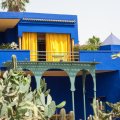The spirit of the French Orientalist through a bucolic walk in a garden in the city centre: sumptuous and unique.
Bewitching! That's the word that best describes the Majorelle garden. The beauty of its exotic plants and the inventiveness of its layout make this place an invitation to contemplation. This haven of peace and greenery was created in the 1920s by French painter Jacques Majorelle, a botanist and great admirer of Moroccan flora. After arriving in Marrakech in 1917 to treat his tuberculosis, Majorelle travelled the country, sketching scenes of daily life, before creating the ceiling of the Mamounia hotel restaurant and acquiring the property. It was around his villa-workshop, designed in 1931 by architect Paul Sinoir, that he had the rarest species planted, from Moroccan soil or more exotic locations: bougainvilleas, banana trees, palms, giant bamboos, yuccas, philodendrons, geraniums, among other species. After Majorelle's death in 1962, the garden fell into neglect, and the luxuriant vegetation was almost entirely replanted by the new owners, Yves Saint-Laurent and Pierre Bergé. More than 300 species of plant now thrive, either in the ground or in vast, colorful, surrealist pots. YSL used color as a creative palette, and it is in the garden that the ashes of the couturier, who died in 2008, are laid to rest. In the warmer hours, the Majorelle garden is crowded with visitors looking for a spot of fresh air near the countless basins and ponds where papyrus and water lilies flourish. The painter's former studio, adjoining a pergola furnished in the purest Art Deco style and with walls of a surprising royal blue (the famous Majorelle blue), is now transformed into a small museum of Berber Art, after having long been a museum of Islamic Art. Inaugurated in 2011, this 200 m² museum houses the personal collections of Pierre Bergé who, fascinated by Berber culture and art, brought together some 600 objects acquired during his various travels, from the Rif to the Sahara. Visitors are invited to discover the culture of the Imazighen (Berbers) through four thematic rooms. Maps, explanatory labels (in French, English and Arabic), photographs, archive films and audiovisual documents accompany the scenography of the tour. To leave the museum, there's a small bookshop with a fine selection of works on this culture. The revenues generated by the Foundation have enabled the construction of the Yves Saint-Laurent Museum, located next door, whose astonishing architecture alone is worth the detour.
Did you know? This review was written by our professional authors.
Book the Best Activities with Get Your Guide
Members' reviews on JARDIN MAJORELLE
The ratings and reviews below reflect the subjective opinions of members and not the opinion of The Little Witty.
Situé à côté du musée Yves Saint-Laurent, dont il abrite les cendres du couturier,il accueille également le musée d'art islamique.
Par contre le musée Yves Saint-Laurent, sans grand intérêt, je trouve cela cher pour ce que c'est.
A noter vous pouvez choisir à l'entrée de prendre un billet pour visiter le jardin le musée berbère et le musée Yves St Laurent pour 180 dirhams (moins si vous êtes résidents du Maroc) ou prendre une ou deux entrées au choix (jardin 70 dirhams et musée berbère 30 dirhams)
A savoir , les entrées des musées et bâtiments touristiques ont pratiquement toujours deux tarifs, un pour les touristes et un pour les habitants du Maroc .
Find unique holiday offers with our partners















Des cactus et plantes diverses ramenées par Jacques Majorelle durant ses voyages. Un endroit charmant.
Je le recommande. Par contre je conseille de le faire avec un organisme, ce qui permet de ne pas faire la queue à l’entrée ou d'y aller avec un enfant, ce qui vous permettre d'accéder à la file prioritaire.